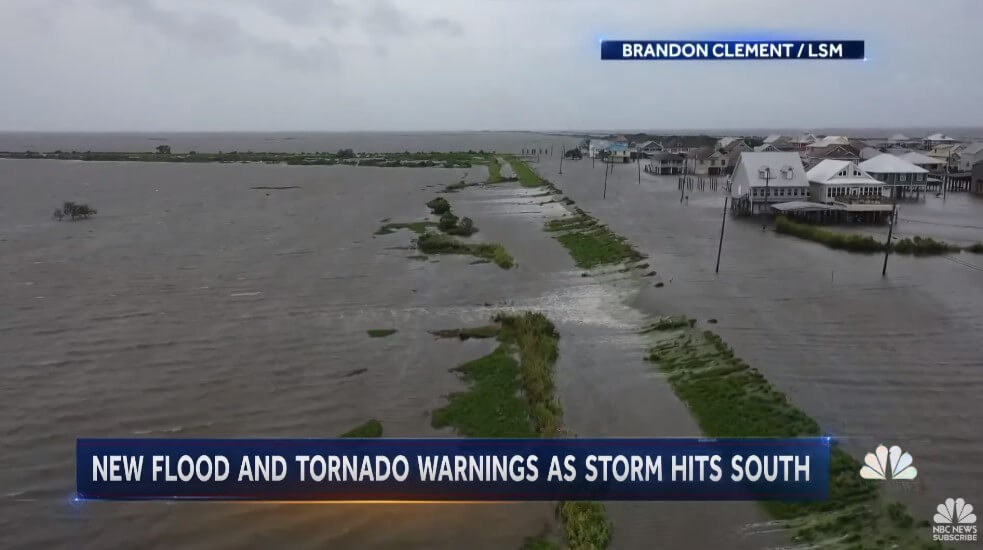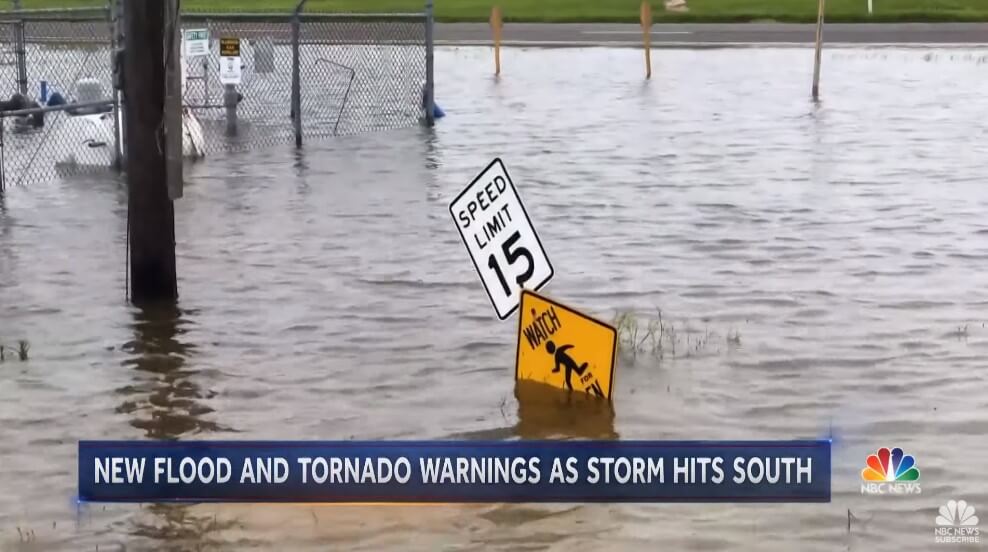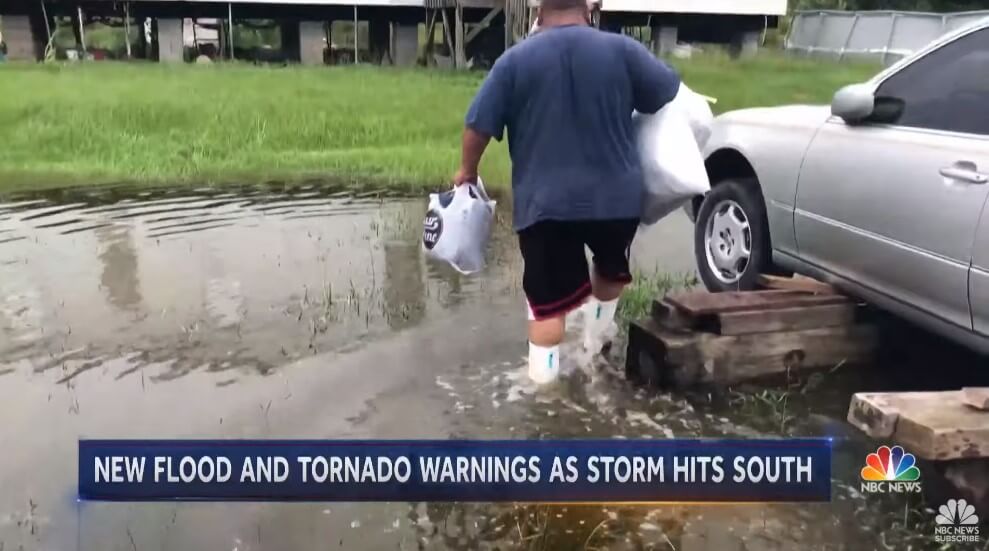Flooded homes, torn down roofs: Barry's storm is heading north, under the threat of 11 million people. PHOTO, VIDEO
Storm Barry has weakened to a tropical depression, but authorities are still warning of dangerous flooding. Severe weather leaves Louisiana and moves into Arkansas. 11 million people are at risk of dangerous floods.

Photo: video frame YouTube / CBC News: The National
According to the National Hurricane Center (NHC), Storm Barry weakened to a tropical depression on Sunday, July 14, moving north through Louisiana at about 9 miles (14 km) per hour - slower than a cyclist, notes CNN.
The storm system actually hung over the state, flooding the already flooded cities with rain. Millions of local residents were at risk of catastrophic floods.
Joseph Colbert, inspecting the damage to his mobile home in Louisiana, found that the storm had torn off the roof covering and had broken the windows, but everyone was still alive.
“We survived,” said a man who had to evacuate after his home was damaged, “and that’s the most important thing.”
On the subject: 5 US cities most vulnerable to hurricanes

Photo: video frame YouTube / NBC News
According to forecasts, Barry will shed rain from 3 to 6 inches (7-15 cm) of rain in the direction from the lower Mississippi valley through the regions of Arkansas, western Tennessee and northwestern Mississippi in the near future. In some areas, precipitation reached 15 inches (38 cm) at the time Barry residuals were observed in the Ohio Valley.

Photo: video frame YouTube / NBC News
According to CNN's meteorologist Michael Guy, on July 14, the threat of severe flooding affected more than 11 millions of people living from the Gulf Coast in Louisiana and Mississippi to the southern tip of Illinois.
Guy said that during the day torrential rains and tornadoes are possible from the coast of the Gulf of Mexico to the middle of the Mississippi River valley.
It was a woman who was airlifted by Storm Barry.
Coast Guard crews rescued from the rooftops, in flooded areas of South of New Orleans. #StormBarry #NewOrleans pic.twitter.com/iK1LgCD8nN
- On Demand News (@ODN) July 14, 2019
According to NHC forecasts, the tropical depression center will move to Arkansas on July 15.
On the subject: 10 items required in case of emergency evacuation
Colbert recalled how, on Saturday, he and his brother worked under a carport when he heard a crash.
“I think its epicenter was above us at that moment,” he said. “And things got really bad.”

Photo: video frame YouTube / NBC News
He remembered how the windows were beating.
“All the windows are broken... in the kitchen, in the bathroom,” the man says.
On the subject: How to insure home and property from floods in the US

Photo: video frame YouTube / CBC News: The National
“It sounded like a train,” Colbert said, adding that he ran to the trailer and found a gaping hole where the roof should have been.
#StormBarry
???RT @WeatherNation: # Terrebonne Parish in #Louisiana was hard-hit with #storm surge inundation on Saturday. Here's a few scenes from the area. #LAwx #Barry pic.twitter.com/zCPzk60NPs- Haida Princess (Lori) (@HaidaPrincess) July 13, 2019
July 13 in St. Mary’s County in Louisiana broke three water dams, said David Nuckwin, director of internal security and emergency situations.
About 60 people in Glencoe had to be evacuated, but Naquin said he believed only a few houses were flooded. Throughout the community, 14 inches (almost 7 cm) of rain fell on July 18, more than the previous day. 70% of residents lost electricity.
According to Entergy Louisiana and Cleco, at least 55 000 people across the state were left without light.

Photo: video frame YouTube / CBC News: The National
Louisiana Governor John Bel Edwards said that state agencies in three districts, including St. Mary's, will be closed on July 15 due to power outages. All other state offices will work as usual.
There is also good news: fears about catastrophic storm surges that could break through the dam and flood New Orleans did not materialize.
General attention was focused on the Mississippi River: forecasts showed a possible storm surge in 2-3 feet (30-60 cm), which could raise the level of the river to 19 feet (5,8 m) in New Orleans. Dams protect against surges up to 20 feet (6 meters) high.

New Orleans. Photo: video frame YouTube / CBC News: The National
But the storm surge was lower than expected. And even despite heavy rain, the National Meteorological Service is now predicting that the river will rise only up to 17,1 feet (5,2 m), and the next surge is expected on July 15.
“I am extremely grateful that the predicted rain and flooding did not occur,” Governor Edwards said. “It was a storm that could have behaved very, very differently.”
Read also on ForumDaily:
Another storm struck another part of the United States: two people have already died. A PHOTO. VIDEO
Storm Barry is increasing, threatening Louisiana large-scale flooding. A PHOTO. VIDEO
Subscribe to ForumDaily on Google NewsDo you want more important and interesting news about life in the USA and immigration to America? — support us donate! Also subscribe to our page Facebook. Select the “Priority in display” option and read us first. Also, don't forget to subscribe to our РєР ° РЅР ° Р »РІ Telegram and Instagram- there is a lot of interesting things there. And join thousands of readers ForumDaily New York — there you will find a lot of interesting and positive information about life in the metropolis.











